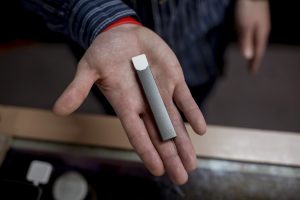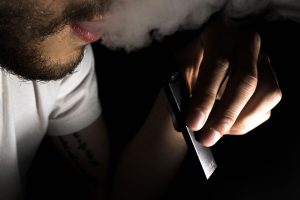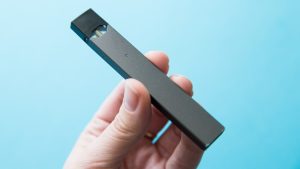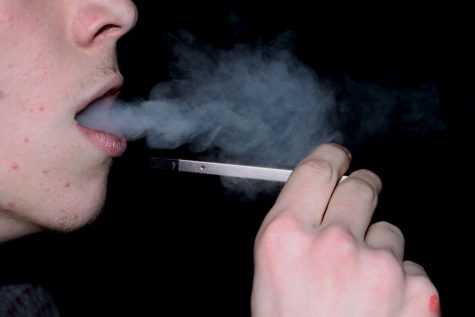Over one million high schoolers do it nationwide. Over 300 thousand middle schoolers use it as well. It’s still considered illegal for minors. Over 20 percent of the WIS Upper School students admitted to using e-cigarettes, especially Juuls, off-campus, according to a health survey conducted earlier this year.
The Food and Drug Administration (FDA) calls e-cigarette usage a national epidemic among youth. On the very first day of school, the Upper School administration decided to announce their modified vaping policy, highlighting Juuling.
According to both students and the administration, Juuling on-campus last year was not uncommon. Juuling is a form of vaping from a type of nicotine filled e-cigarette (a Juul). The Juul appears to be one of the most popular forms of e-cigarette on and off-campus among high school students. “Every single friend of mine owns a Juul and uses it off-campus, all my male friends have Juuled on-campus,” said student Z*, a Junior at WIS.
The February Independent School Health Check survey states that e-cigarette usage off-campus was over 20 percent and three percent on-campus. Both WIS Dean of Students Beta Eaton and high schoolers questioned the credibility of the Health Check statistics, as students could easily lie without repercussions. The timing of the survey also seemed to decrease its accuracy. “The survey was in February and people started Juuling more on-campus in the late spring when the Juul blew up” Junior student X added.
According to the Bloomberg Opinion, the Juul had an increase in popularity among youth nationwide. Several aspects of the Juul including, its portability, flavourful pods, sleek appearance and the fact that it is easily concealed contributed to its rise in popularity.

Student interviewees at WIS who have admitted to Juuling and agree with these aspects also say they have felt peer pressured into it. In addition, Senior student Y claims that many teenagers find it a softer drug, “some people will Juul and won’t take any other drugs, I mean nicotine, it’s bad for you, but not horrendously bad, it’s a small drug” student Y said.
When students and two faculty members were asked to estimate the percentage of high schoolers who Juuled on-campus, the numbers ranged from five to 25 percent on-campus and 30 to 70 percent regularly off-campus. Most predictions were higher than the amount in the Health Check. However, talk of Juuling could be more prevalent than the action itself. Some of the predictions were based on word around campus without substantial evidence.
Due to the overall awareness of on-campus Juuling, many students wonder whether the new vaping policy was not only implemented due to national increase, as stated during the first assembly, but to curb on-campus Juuling at WIS as well. Some, interviewed by Dateline, alluded to on-campus incidents that could have contributed to the new policy. “I’m pretty sure the administration kind of started to figure out at the end of last year that people obviously Juuled on-campus and I feel like it has to do with certain incidents and people getting caught,” Sophomore student D said.

Student D’s suspicions have been confirmed. However, only one incident where students were caught Juuling was highlighted by Eaton who said, “last year there was an incident where a teacher walked into a bathroom and a Juul fell out of the student’s hand in front of the teacher.” The incident was mentioned several times by student interviewees.
One of the students involved in this incident recounts it saying, “I was in the bathroom during one of the 10 minute breaks borrowing a Juul from a friend and we took turns hitting it. The teacher couldn’t come in because my friend leaned [on the door] while we tried to wave away the smoke and hide the Juul, but in doing so the Juul was accidentally knocked out of our hands and fell to the floor. I tied to pick it up but the teacher came in and saw it” former WIS student, Sophomore H said. The students were then taken to Eaton’s office.
Mr. Boehm, the teacher who walked in on the students in the boys bathroom in the Hall of Peace, describes the incident saying “I had to go to the bathroom and the door wasn’t opening, I was confused, I honestly just thought the door was jammed, I’m not that big of a guy but I pushed into the door and I nearly knocked over the young man on the other side causing the Juul to fall out of his hand.” Boehm said that the demeanor of the students and the location made him believe this was not the first time a student had Juuled on-campus. Sophomore H, confirmed that this wasn’t the first time he had Juuled on-campus.

According to other students, there were definitely more instances last year where students Juuled on-campus and were not caught. Bathrooms, locker rooms and outside on the fringe of the campus were mentioned as common places to Juul undetected. “In class, while the teacher was in the room, one of my classmates went to the other and said ‘Oh hey, I’m going to the bathroom’ really suggestively, then the other responded ‘Oh I got you’ before reaching into their bag, slipping out a Juul and handed it to the other” student A said. Student Z admitted to being one of the two students involved.
Apart from Juuling on-campus without repercussions, three interviewees in 11th and 12th grade claim to have witnessed Juuling in class. Student Z claims to have seen students Juul on multiple occasions in class when the teacher was not in the room and once when the teacher was in the room. “I was sitting in a class, when the teacher was in the room and this person, who was pretty well known for Juuling repeatedly would look around, hunch down in his chair, kind of curl up, put his mouth and nose underneath his hoodie for a few seconds and take a hit of his Juul” Junior student C said.
Dean Eaton speculates that 10th and 11th graders Juul on-campus the most, however many students have said that the current Freshmen Juul as well and have been since 8th grade. Sophomore student D confirms this saying, “I definitely know some current Freshmen Juul. I actually sold a Juul to a current Freshman last year when they were in 8th grade because I advertised it on Snapchat.” Student D claims to have sold around eight to 10 Juuls to WIS students last year, two 8th graders, several Freshman and one Sophomore. Student D states that none of the transactions happened on-campus.

Several students and staff said that, due to its portability and fleeting cloud, a Juul can be effortlessly bought and used on-campus. “It’s as easy as putting it in your backpack and going to the locker room” student B said, who previously witnessed this action. Eaton also states how effortlessly a student can Juul on-campus saying “It’s one of the easiest things students can get away with because it’s so sneaky.” A Juul’s portability and easy concealment is also a driving factor for its popularity.
However there is still significantly more use off-campus than on. Senior Y states, “kids our age are obviously going to experiment with drugs but kids know they are here [at WIS] to learn , we obviously do it more off-campus.”
Some students argue that not everyone can get away with Juuling on-campus. It requires some experience, technique, or prior information about the inner workings of WIS. Two freshmen stated that knowing where to Juul is key, “You need to be in the right place at the right time” said Freshman student F, “and you need to know how to hide” added Freshman G.

With several interviewees claiming it is easy to Juul on-campus, highlighting specific incidents when they’ve witnessed Juuling on-campus and some even admitting to Juuling on-campus themselves, it begs the question, what is the administration’s response?
Dean Eaton states that Juuling on-campus could be damaging to WIS’ reputation. “This is an open campus, other people besides us are coming on to the campus. What happens when younger children or neighbours see us not uphold the community norms? It doesn’t make WIS look like a community that respects one another” Eaton said. She predicts that the Tregaron conservancy/forest is one of the most common places to Juul along with bathrooms, locker rooms and the field.
Apart from introducing the new policy which specifies a one day suspension for any drug usage on-campus, during faculty meetings teachers are now being educated and know how to identify a Juul which was previously challenging due to its design. “Teachers have to know what a Juul looks like by now” student A said. Mr. Boehm states that after the incident with the Sophomores, the teachers had a meeting to bring awareness to the issue of Juuling on-campus and how to combat these problems.

Informing the students about the health risks of Juuling is also a top priority for the administration. Eaton highlights the lack of knowledge about e-cigarettes within the student body saying, “One of the biggest things that people don’t recognize is that these devices and e-cigarettes have nicotine in them, despite the companies claiming that they help smokers quit.”
According to the Truth Initiative, a Juul cartridge or pod contains about as much nicotine as a pack of cigarettes. Nicotine is just as addictive as heroin and the long term negative cardiovascular, respiratory and reproductive consequences outweigh the benefits.
There are still many unknown side effects of e-cigarette usage. Current side effects stated by Health Magazine, Shape, increase your risk of cancer, susceptibility to respiratory related diseases and irregularities in heartbeat that could, in rare cases, lead to heart attacks or death. In addition, the e-liquid in a Juul pod/cartridge contains several toxic metals such as Lead, Chromium and Nickel, according to a study by PubMed. CNN states that “e-cigarettes are also a gateway drug for traditional tobacco use for many young kids”.
An article by the New York Times highlights the accusations Juul received for “luring teenagers” to gain “customers for life.” The article states that the companies were aware the product could appeal to underage customers through social media but did not change their policies until late 2016.
Since the accusations, Juul modified some of their policies. Now, companies regulate the ages of all people featured in their advertisements, stating they must be over 35. Previously, accusers claimed that the actors seemed too young and would make Juuling appealing to minors. In addition, Juul changed the names of their flavourful pods to simply Cucumber and Créme which were previously Cool Cucumber and Créme Brulée.

Many interviewees claim that Juuling at WIS decreased since the spring of 2018. Introducing the new policy and explaining the consequences has been, to an extent, effective, with a definite decrease in Juuling on-campus, more with the girls than the boys according to two interviewees.
Student Z stated that they no longer bring their Juul onto the campus due to the new policy. Sophomore D said, “people are definitely scared, I know a lot of people who still Juul at school but I know a lot of people have also stopped bringing Juuls to school because of the policy”. Since last year, Sophomore D also stopped Juuling stating that Juuling didn’t feel like them and they didn’t want to succumb to peer pressure.
However the new policy has not curbed Juuling all together as student A states, “I asked a student who I knew Juuled on-campus what he thought about the new policy. They said that they still brought their Juul on-campus, then pulled it out and showed it to me with a teacher right around the corner.”
The students and the administration both agree that there is only so much one can do to stop students from Juuling. “Teachers are aware but they can’t stand around the bathroom all day trying to catch someone” student A said. The administration states that it is doing all it can to protect its students. Teachers can’t focus on everything happening in a classroom while also going through the day’s lesson. Eaton explains that WIS does not have metal detectors and video cameras in order to still uphold WIS values of trust and community. “Our eyes are not everywhere” Eaton said, “but we are trying our best.”
By Celeste Bloom
*This article contains several anonymous sources. Our policy for anonymous sources is accessible here or through our homepage.

































































